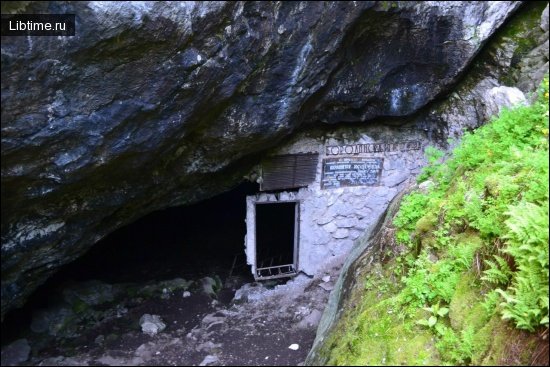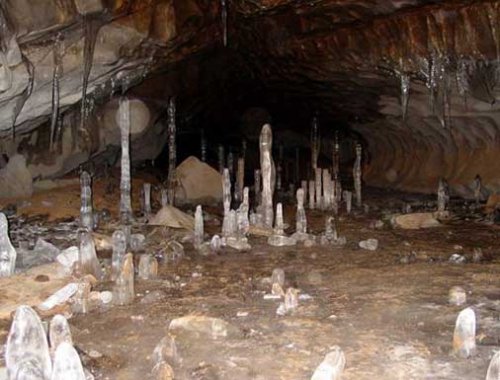Formation of karst caves
Karst caves are underground cavities formed in the thickness of the earth's crust, in areas where easily soluble carbonate and halogen rocks are distributed, subjected to leaching and mechanical action, these rocks are gradually destroyed, which leads to the formation of various karst forms.
Among them the most interesting are underground karst forms - caves, mines and wells, sometimes characterized by a very complex structure. 
Among them there are carbonate rocks (limestones, dolomites, writing chalk, marbles), sulfate (gypsums, anhydrite) and halide (rock salt, potassium salt). Karsting rocks have a very wide distribution.
In many places they are overlapped by a low thickness cover of sandy-clay deposits or directly come to the surface, which favors the active development of karst processes and the formation of various karst forms.
The intensity of karst formation is also significantly influenced by the thickness of rocks, their chemical composition and peculiarities of occurrence.
Water - the builder of karst caves
As already mentioned, the builder of karst caves is water. However, for water to be able to dissolve rocks, they must be permeable, i.e. fractured. The fracturing of rocks is one of the basic conditions for the development of karst.
If a carbonate or sulfate massif is monolithic and consists of solid rock differences devoid of fracturing, it is not exposed to karst processes.
However, this phenomenon is rare because limestones, dolomites and gypsums are fractured in nature. Cracks dissecting limestone massifs have different origins.
Lithogenetic, tectonic, mechanical unloading and weathering cracks are distinguished. The most common are tectonic fractures, which usually cut different layers of sedimentary rocks without refracting during the transition from one layer to another and without changing their width.
Tectonic fracturing is characterized by the development of complex mutually perpendicular fractures 1-2 mm wide. The greatest fragmentation and fracturing of rocks are characterized in the zones of tectonic disturbances.
Falling on the surface of karst massif, atmospheric precipitation penetrates into the depth of this massif through cracks of different origin. Circulating through underground channels, water leaches the rock, gradually widens underground passages and sometimes forms huge grottoes.
Moving water is the third prerequisite for the development of karst processes. Without water dissolving and destroying rocks, there would be no karst caves.
That is why the peculiarities of the hydrographic network and the peculiarity of the hydrogeological regime largely determine the degree of trickiness of karst strata, the intensity of leaching processes and the conditions for the development of underground cavities.
Rain and snowmelt waters
The main role in the formation of many karst cavities is played by infiltrational and influational rain and snowmelt waters.
Such caves are of corrosive-erosive origin, since the destruction of the rock occurs both by chemical leaching and by mechanical erosion.
However, it should not be thought that these processes occur simultaneously and continuously. At different stages of cave development and in different parts of caves, one of these processes usually dominates.
The formation of some caves is entirely associated with either corrosive or erosive processes. There are also nival-corrosive caves, which owe their origin to the activity of melted snow water in the contact zone between the snow strata and karsted rock. These include, for example, relatively shallow (up to 70 m) vertical cavities in the Crimea and the Caucasus.
Many caves arose as a result of roof collapse over underground corrosion-erosion cavities. Some natural cavities were formed by leaching of rocks by artesian, mineral and thermal waters rising through cracks.
Thus, karst caves may be of corrosive, corrosive-erosive, erosional, nivalic-corrosive, corrosive-gravitational (sinkhole), hydrothermal, and heterogeneous origin. 
Condensation waters
In addition to infiltration, inflow and pressure waters, condensation waters also play a role in the formation of caves, which, collecting on the walls and ceiling of caves, corrode them, creating bizarre patterns.
Unlike underground streams, condensation waters affect the entire surface of the cavity, and therefore have the greatest influence on the morphology of caves.
Especially favorable conditions for condensation are characterized by small cavities located at a considerable depth from the surface, because the amount of condensation moisture is in direct correlation with the intensity of air exchange and in inverse correlation with the cavity volume.
Observations conducted in the Mountain Crimea showed that in the studied karst caves during the year condensed 3201.6 m3 of water, and in the underground cavities of the entire main ridge 2500 times more (i.e. 0.008004 km3).
These waters are characterized by great aggressiveness. Their hardness exceeds 6 mg-eq (300 mg/l). Thus, at the expense of infiltration waters, the caves of the Mountain Crimea, as simple calculations show, increase in comparison with the total volume by about 5.3%.
The average mineralization of condensation waters is about 300 mg/l, hence they carry out 2401.2 tons (8004 - 106l X 300 mg/l) of calcium carbonate during a year. The total calcium carbonate removal by karst springs in the Mountain Crimea is about 45,000 tons/year.
Consequently, the role of condensation waters in the formation of underground cavities is relatively small, and their impact on the rock as a denudation agent is limited mainly to the warm period.


